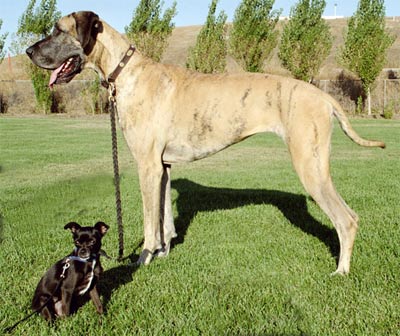The Abhorrence of Sharks
Posted by Shelly in The Abhorrence of Sharks
Shark Encounters in Hawaii
Posted by Shelly in Shark Encounters in Hawaii
From Shark Anatomy To Shark Bite
Posted by Shelly in From Shark Anatomy To Shark Bite
Dog Aggression - Understanding Why?
Posted by Shelly in Dog Aggression - Understanding Why?
Aggression is one of the main reasons why dogs are euthanized or relocated, at least 30% of all dogs in rescue centers are there due to the incidence of aggressive behavior in one way or another. It is actually rare to have a dog that is attacking have a single type of aggression, and most dogs have more than one of the following types of behavior.
It would be prudent, before embarking on a program of aggressive behavior modification, to rule out any medical reason for that behavior, especially if there is a sudden change in the temperament of the dog. Their are some fifty-odd different medical reasons why a dog may be showing aggressive tendencies, these range from the pain of thyroid dysfunction, epilepsy, hypoglycemia and diabetes.
The following is a list of the most common attacks and why they might occur. This is only part of the total rates. Due to space limitations can only be a fleeting reference.
1. Fear / Nervous Aggression (Interdog)
Very often, this behavior has its roots directly to the breeding of the mother. The breeders that breed from fearful and shy dogs often make excuses why you can not see the dam. If you do see a litter of puppies and the mother is afraid, then do not even think about buying a puppy. It will be almost a certainty that the pups will inherit some of the features of the mother, through genetics and socialization, genetically the pups may inherit her timidity and by the time they are seen with her fear and follow their example .
Scientific research has shown that even the puppies born to a mother strong and stable then got a dog that is afraid to collect some of the habits unstable fearful dog. Other reasons for this type of problem is the fear when the puppy or dog is attacked by another dog, especially while in the lead, no means of escape and restricted to display submissive body language to the attacker.
The lack of early socialization can also have an effect on this behavior, if the puppy, especially between the ages of seven and sixteen weeks, care is not socialized with both adults and puppies alike, then learn to "know and greet ". Dogs learn complex body language at this age is crucial to their subsequent behavior when approaching strange dogs. If you are unable to perform any or understand the greeting rituals, then they are immediately viewed with suspicion by the dog approaches, and conflicts can arise
How can you tell if you fear?
With aggressive dogs, nervous and afraid you will find that they will react aggressively to any dog, whether male or female. The behavior is often worse if the dog is in the lead or is cornered, especially near the owner, who supports the conduct, (although unknowingly) to get nervous and agitated as the approaches of other dogs.
This is manifested in a tightening of the head and shoulders. Nervous owners also kick a cloud of adrenaline that the dog instantly detects, this causes it to see what is causing the problem. We see that the dog comes over and reacts accordingly. This type of dog is also normally a crier, who will rush and bark at the dog approaches, but generally will not break unless all options have been exhausted. that is, flight or freezing and after all, the threat of positions that the other dog got too close yet.
This problem can be diagnosed if a person who is confident around dogs (the dog is not well known) it out of his head. This will not terrible vibrations of the same owner, therefore the reaction from other dogs that are close to be less intense. It is a good way to tell if your dog suffers fear aggression, since the behavior is not exposed or will be less pronounced. The owner can use a desensitization program for both the dog and themselves.
2. Fear / Nervous Aggression (Inter-human)
Again, this may be caused by lack of early socialization, poor education and sometimes the lack of management at an early age, after only two weeks old. Puppies that are not handled with care and often by the breeder does not receive olfactory and tactile strong bond with humans. This is often the case with puppies and breeding dogs born to large players. This treatment at a young age causes a mild stress response in the small farming, which benefits their ability to cope with many situations, including people and dogs in adulthood
Nervous and fear of attack is always defensive in nature, sometimes associated with the sex of the person. If the breeder was a woman, and very few men visited or handled the puppies, then shyness and fear can be worse than men. This particular problem, such as hostility Interdog, manifests itself mainly with the people instead of the crowds.
You will find that the dog barks, but will be under a table or behind a sofa. The tail is down and it may seem overtly aggressive dogs balance and weight will be on the back foot and not on the front legs. This demonstrates that the dog wants you to go and not trying to bite first or attack you. A gradual and careful introduction to the stimulus that provokes fear with positive reinforcement for calm behavior is the way to overcome such problem, although the dog can rarely achieve a complete and full recovery and will never be the life and soul of the park and parts of congratulations.
3. Frustration Aggression
Research has shown that dogs are not allowed to interact "normally" with people and dogs that were prone to displays of temper and behavior was overtly aggressive are dogs that are generally restricted or restricted interactions normal (interactions with people, other dogs, and the outside world). The dog develops an intense desire to have access to all these things he wants.
This desire can lead to escape behavior and roaming, agitation, seizures and unprovoked biting. It is often observed in dogs that are left on floors tethered to the left in the gardens, or near a window where you can see the things they want to interact, but can not reach them so show no aggression caused. To some extent, the attack demonstrated that the postman is based on frustration. I've seen dogs attack their owner or a second dog at home because you can not get to the dealer.
As with most early socialization aggressive behavior and an understanding of how dogs learn and communicate are essential.
4. Sexual assault.
This type of aggression is generally limited to male dogs. They will mount up to people and other dogs. Mounting activity directed toward humans may reflect a lack of opportunity for the dog to play with other dogs, or an attachment on people in early life, the mounting of other dogs, especially if you initially try to put head on the dog's neck the other can be related to categorize and control the complex behavior. Modification of castration and behavior can help with this problem. Allow the dog to your partner can often be recommended by the amateur dog expert, which usually makes the problem worse.
5 The territorial aggression
This can be towards other dogs, people, or both. By definition, territorial aggression should be addressed to the members of the same species ie other dogs. Domestic dogs, however, seem to regard humans in this respect as fellow human beings, and therefore can direct territorial aggression toward us When dogs display aggression to strangers only in the garden of home ownership, home, or in the courtyard, however, did not respond aggressively to strangers on neutral territory, then territorial aggression is the most likely diagnosis. There are two main motivations for territorial behavior, control, domination is complex, the behavior or the fear / anxiety. It may be worse in such a small space like a car than in an open area. Some dogs, as this may be well at home, but not so good in the garden.
The only answer to this problem is to work on the problem domain / land, in a way that a dog understands its position through a program of behavior modification techniques to reinforce the position. Remember not to praise the cessation of bad behavior instead of praise that bad behavior does not occur in the first place. In other words, say the dog jumps on someone and say "OFF" if the dogs down so as not to praise is praised for inappropriate behavior, which was the jump.
6. Control Complex / Dominant Aggression
The key word is a dirty word in the circles of dog behavior today but if we understand the word means the position and is much more complex than simply aggression, then ignore this area of conflict would be remiss . Initial contact with other dogs is often precautionary and contains many status signals such as tail carriage up and moving quickly from side to side, toes, etc. If the other dog is, then everything is usually But if the fight can be extremely noisy and in some cases very severe. In both the last two examples, dominant and territorial aggression, usually find the dog will pull quite sick in the head. These dogs may also show aggressive tendency towards members of the family that this could lead to an attack if not controlled in its early stages. When working on a program that will give the dog a purpose and position in life, almost a job and teach the dog to walk on a loose leash can sometimes overcome the problem. The type of program I would use is the NILIF program, which means "Nothing in life is free," See my website under the domain
7. Chase or predatory aggression
This can be directed to many things, including dogs, cats, or anything that stimulates a response from persecution. Squirrels are a favorite, as their quick jerky movements seem to stimulate even the most placid of dogs. I see a lot of predatory chase aggression Border Collie instance, particularly stimulants, such as bicycles, scooters and car brokers.
One of the key factors that distinguish predatory aggression from other forms of aggression is that movement is often the trigger. In nature, this movement is in the form of running and escape attempts of some small animals. Abusive behavior can be seen in dogs of either sex and age.
Dogs who show great interest and excited or anxious about the motion or noise of children or other pets should be closely monitored at all times. The prognosis is not good for this type of aggression. Reward training obedience can be helpful, however this is only one use, if the owner / trainer is able to constantly monitor the dog at all times.
It is easier to control the hunting stimulus when directed at cars, joggers, or bikes. There are two common types of treatment include the fight against air used to change the perception of the dogs of the falsely identified prey. Many also believe that punishment works ie noise aversion when the behavior is first stimulated. Pulling water from a car window or sounding an alarm or air horn violation at the exact moment the dog leaves, throwing a plastic bottle with stones of a motorcycle or a car that happens sometimes, you can modify this behavior .
However. To be effective, punishment must be seen as aversive and the time of sanction must be accurate so that the dog associates the punishment with the behavior. Electric shock collars have also been suggested, but are not part of treatment programs that would never recommend.
As mentioned aggression often stems from poor education, lack of socialization, high prey drive, and the basic training of the poor can also exacerbate the situation. However, as stated before it can be related to medical conditions and before embarking on a course of behavior therapy that your dog checked to see if there are any underlying medical condition.
Learned aggression can normally be cured however, hereditary aggression can not, can only be controlled and hopefully contained. Castration sometimes helps, and should be considered in an overall reduction program aggression. In all cases of aggression, you should consider a behaviorist or a dog trainer with experience in these problems before the problems become life threatening for both the dog or the person you are attacking.

































.jpeg)



















